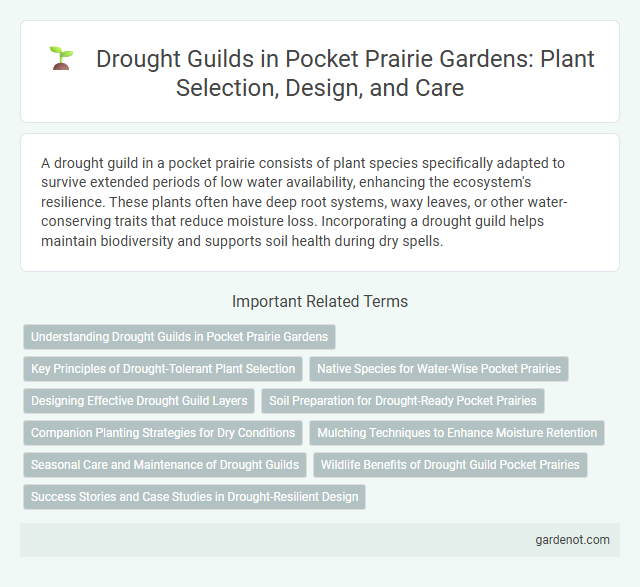A drought guild in a pocket prairie consists of plant species specifically adapted to survive extended periods of low water availability, enhancing the ecosystem's resilience. These plants often have deep root systems, waxy leaves, or other water-conserving traits that reduce moisture loss. Incorporating a drought guild helps maintain biodiversity and supports soil health during dry spells.
Understanding Drought Guilds in Pocket Prairie Gardens
Drought guilds in pocket prairie gardens consist of plant species specifically adapted to survive extended periods of low water availability through traits such as deep root systems, drought tolerance, and efficient water use. These guilds improve garden resilience by maintaining ecosystem functions like soil stabilization, nutrient cycling, and habitat provision during drought conditions. Incorporating native drought-tolerant plants like little bluestem, purple coneflower, and prairie dropseed enhances the sustainability and biodiversity of pocket prairie landscapes.
Key Principles of Drought-Tolerant Plant Selection
Drought guilds emphasize selecting plants with deep root systems, efficient water use, and high tolerance to prolonged dry periods. Prioritizing native species adapted to local climate conditions ensures resilience and sustainability in pocket prairies. Incorporating diverse plant types like succulents, grasses, and shrubs enhances soil moisture retention and ecosystem stability under drought stress.
Native Species for Water-Wise Pocket Prairies
Native species such as Purple Coneflower (Echinacea purpurea), Little Bluestem (Schizachyrium scoparium), and Butterfly Milkweed (Asclepias tuberosa) thrive in drought guilds, requiring minimal water once established. These plants have deep root systems that improve soil structure and increase water infiltration, making them ideal for water-wise pocket prairies. Incorporating native grasses and wildflowers enhances biodiversity and supports local pollinators while maintaining landscape resilience during dry conditions.
Designing Effective Drought Guild Layers
Designing effective drought guild layers involves selecting deep-rooted perennials, drought-tolerant grasses, and native shrubs that maximize water retention and soil stability. Integrating nitrogen-fixing species within these layers enhances soil fertility while reducing irrigation needs. Strategic plant layering optimizes microclimates to minimize evapotranspiration and supports resilient pocket prairie ecosystems under extended dry conditions.
Soil Preparation for Drought-Ready Pocket Prairies
Soil preparation for drought-ready pocket prairies involves enhancing soil structure and moisture retention through organic matter incorporation and deep tilling techniques. Selecting drought-tolerant native grasses and plants that thrive in well-drained, nutrient-rich soils optimizes water use efficiency. Implementing mulch layers and soil amendments like biochar further improves water retention and resilience against prolonged dry spells.
Companion Planting Strategies for Dry Conditions
Drought guilds in pocket prairies utilize companion planting strategies to enhance water retention and improve plant resilience in dry conditions. Deep-rooted species such as prairie coneflower (Rudbeckia) are paired with drought-tolerant grasses like big bluestem (Andropogon gerardii) to optimize soil moisture absorption and reduce evaporation. This synergistic planting reduces irrigation needs while promoting biodiversity and ecosystem stability in arid environments.
Mulching Techniques to Enhance Moisture Retention
Mulching techniques in a drought guild are essential for enhancing soil moisture retention by reducing evaporation and regulating soil temperature. Organic mulches such as straw, wood chips, and compost improve water infiltration and promote beneficial microbial activity, which supports plant resilience during dry periods. Applying a thick layer of mulch around drought-tolerant plants in a pocket prairie helps maintain consistent soil moisture and minimizes water stress.
Seasonal Care and Maintenance of Drought Guilds
Seasonal care and maintenance of drought guilds in pocket prairies involve strategic watering during prolonged dry spells to sustain deep-rooted perennials and drought-tolerant plants. Mulching around the base of guild plants conserves soil moisture and regulates temperature, reducing the impact of water stress. Periodic pruning and removal of invasive species enhance plant health and encourage resilient growth in drought-prone environments.
Wildlife Benefits of Drought Guild Pocket Prairies
Drought guild pocket prairies provide critical habitat and food sources for diverse wildlife, including pollinators, birds, and small mammals, by supporting native drought-tolerant plant species. These prairies enhance ecosystem resilience by maintaining soil moisture and offering shelter during dry conditions, promoting biodiversity even in arid environments. The intricate plant-animal interactions in drought guild pocket prairies contribute to sustaining local food webs and improving habitat connectivity in urban and rural landscapes.
Success Stories and Case Studies in Drought-Resilient Design
Drought guilds in pocket prairie designs have demonstrated remarkable success in promoting water-efficient ecosystems by integrating deep-rooted native plants such as prairie dropseed and purple coneflower. Case studies highlight improved soil moisture retention and biodiversity, with projects in the Midwest showing a 40% increase in drought resilience over conventional landscaping. These drought guilds optimize plant synergy to reduce irrigation needs while supporting pollinators and long-term ecosystem stability.
Drought guild Infographic

 gardenot.com
gardenot.com